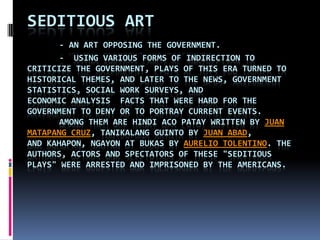
seditious art and american colonial
- 1. Seditious art - an art opposing the government. - Using various forms of indirection to criticize the government, plays of this era turned to historical themes, and later to the news, government statistics, social work surveys, and economic analysis facts that were hard for the government to deny or to portray current events. Among them are Hindi AcoPatay written by Juan Matapang Cruz, TanikalangGuinto by Juan Abad, and Kahapon, Ngayon at Bukas by Aurelio Tolentino. The authors, actors and spectators of these "seditious plays" were arrested and imprisoned by the Americans.
- 2. May 8, 1903 – Hindi AcoPatay (I Am Not Dead) is presented at a local theater. The play talks about the love between Karangalan (honor) and Tangulan (defender, patriot) and their opposition to Macamcam (the American government). Tangulan and Macamcam battle it out and Tangulan dies. However, he screams out “I am not dead!” The scenery then changes to a rising sun on the Katipunan flag, symbolizing freedom. A fight breaks out in the theatre audience between the white men and the brown men.May 14, 1903 – Kahapon, Ngayon at Bukas (Yesterday, Today and Tomorrow), by Aurelio Tolentino, talks about Filipino oppressors from yesterday (the Chinese), today (the Spanish), and tomorrow (the Americans). Inangbaya (the Philippines) and her son Tagailog (the Filipinos) conquer all of them. The scene then proceeds with the taking down of the American flag and stepping on it, causing another riot between the white and brown men.
- 4. TanikalangGinto- isangdramangsimbolikonanagpapahayagsaepektongkaranasanngmga Pilipino noongpanahonngkolonyalismosamakabagongkabataang Pilipino. Hindi nakaranasngkaparehongpagdurusangdinanasngmga Pilipino noon angmga Pilipino sakasalukuyan. Hindi namaaalissaatingisipannaminsansakasaysayanngPilipinas, napasailalimtayosakapangyarihanngibangestado.
- 7. American colonialDuring the American colonial period of the Philippines (1898-1943), the American government gave priority to education in the Philippines.Education became very important for the Filipinos. The spread of democracy and formation of good citizens, including the rights and responsibilities of the people, were the focus of American education in the country. Education allowed the Americans to spread or share their culture, particularly the English language, to the Filipinos. A new set of colonizers brought about new changes in Philippine literature. New literary forms such as free verse [in poetry], the modern short story and the critical essay were introduced.
- 8. Poets- Jose Garcia Villa used free verse,- Angela Manalang Gloria, a woman poet described as ahead of her time. Despite the threat of censorship by the new dispensation, more writers turned up "seditious works" and popular writing in the native languages bloomed through the weekly outlets like Liwayway and Bisaya.- Alejandro G. Abadilla advocated modernism in poetry. Abadilla later influenced young poets who wrote modern verses in the 1960s such as - VirgilioS. Almario, Pedro I. Ricarte and Rolando S. Tinio. Short storysuccessful short story in English written by a Filipino- Arturo B. Rotor and Manuel E. Arguilla
- 9. Strategically located at the mouth of Manila Bay, the island fortress of Corregidor was seen by the American as an important military installation for the defense of their power within the archipelago
- 10. Its facilities were used for the study and development of the country's rich mineral, agricultural and forest resources
- 11. Army and Navy Club building on the Manila seafront.
- 12. Mehan Garden circa in 1900’s Botanical garden one of the oldest botanical institutions.
- 13. Changes in Philippine Cultureduring the American PeriodGovernment-Democracy was the greatestlegacy the Americans gave us.The government has threebranches: executive (president),legislative (senate and congress)and the judiciary.(department of justice)
- 14. Education - Schools were built all over thecountry and making English as amedium of instructions.The first teachers were called Thomasites because they came onboard the SS Thomas.The University of the Philippines,Philippine Normal College and otheragricultural schools wereestablished.
- 15. Religion- Protestantism was introduced.- In 1918, more or less than 300,00Filipinos became protestant.- The church an the state (government)were separated. Freedom of religion waspracticed -Transportation and Communication wasimproved.-Americans built roads, streets and bridgesfor efficient movement of products andservices.-Examples:Burnham Park, Kennon Road, Camp JohnHay etc
- 16. Kennon Road 1910
- 18. Camp John Hay 1901
- 19. Entertainment- Music and dance- Hollywood movies became popular inthe country. New kinds of music anddance were introduced like rock n roll,boogie, jazz, tango, chacha, polka, andrhumba.-Filipinos learned to watch and playgames like table tennis, basketball,volleyball, boxing, and football.-The Filipinos learned the value ofcleanliness and healthy practices.-They were taught proper hygieneto make them healthy and be freefrom contagious diseases.-Hospitals, clinics, and healthcenters were built. Public hospitalsfor leper victims were alsoestablished.
- 20. Mode of Dressing was changed.- The women learned to weardresses, high-heeled shoes andhand bags. While the men woresuits, polo shirts, ties and jeans. Food like ice cream, cakes, beef steak,hotdog, hamburgers, sandwiches, cookies,and donuts were introduced.- American architecture are still presenttoday. Up, PNU, Manila Hotel and PGH aresome examples.- Boulevards, zone districts, streets, centersof leisure were also built. Livelihood-The Philippine economy was alsoimproved due to increase agriculturalproduction and development of newindustries.
- 21. The Filiino attitude was graduallychanged. We learned to be frank,humorous, belief in rights and freedom,and love for sports.“Pagmamano” was replaced by kissing thecheeks of parents and elders as a sign ofrespect.The English language was widelytaught all over the country. Soon,some english words became part ofour vocabulary. Filipinos adoptedAmerican names like Charlie, Anna,Francis, and Cherry.
- 22. 1st Television
- 23. An 1899 photograph of Filipino military officers.